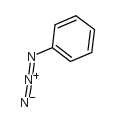Benzene, azido-

Benzene, azido- structure
|
Common Name | Benzene, azido- | ||
|---|---|---|---|---|
| CAS Number | 622-37-7 | Molecular Weight | 119.12400 | |
| Density | 1.0860 | Boiling Point | 212.39°C (rough estimate) | |
| Molecular Formula | C6H5N3 | Melting Point | -27.5°C | |
| MSDS | USA | Flash Point | -12ºC | |
| Symbol |


GHS02, GHS08 |
Signal Word | Danger | |
|
Regioselective Sequential Modification of Chitosan via Azide-Alkyne Click Reaction: Synthesis, Characterization, and Antimicrobial Activity of Chitosan Derivatives and Nanoparticles.
PLoS ONE 10 , e0123084, (2015) Recently, the attention of researchers has been drawn toward the synthesis of chitosan derivatives and their nanoparticles with enhanced antimicrobial activities. In this study, chitosan derivatives with different azides and alkyne groups were synthesized usi... |
|
|
An automated multiplex specific IgE assay system using a photoimmobilized microarray.
J. Biotechnol. 161(4) , 414-21, (2012) An automated microarray diagnostic system for specific IgE using photoimmobilized allergen has been developed. Photoimmobilization is useful for preparing microarrays, where various types of biological components are covalently immobilized on a plate. Because... |
|
|
Inhibition of monoamine oxidase by phenyl azides.
J. Neurochem. 45(3) , 940-5, (1985) We had previously shown that 4-fluoro-3-nitrophenyl azide (FNPA) is a competitive inhibitor of both types of monoamine oxidase (MAO) in the dark, but it is a preferential photoaffinity label for only the type B MAO (MAO-B). Recently we synthesized a number of... |
|
|
Probing the active site of a diels-alderase ribozyme by photoaffinity cross-linking.
J. Am. Chem. Soc. 130(27) , 8594-5, (2008) The active site of a Diels-Alderase ribozyme is located in solution by photoaffinity cross-linking using a productlike azidobenzyl probe. Two key nucleotides are identified that contact the Diels-Alder product in a conformation-dependent fashion. The design o... |
|
|
An ultrafast study of phenyl azide: the direct observation of phenylnitrenium ion.
Org. Lett. 9(20) , 3973-6, (2007) Ultrafast photolysis (lambda(ex) = 308 nm) of phenyl azide in 100% formic acid produces a broadly absorbing transient within the instrument time resolution (300 fs), which is assigned to an excited state of the azide. The azide excited state fragments within ... |
|
|
Photochemical fishing approaches for identifying target proteins and elucidating the structure of a ligand-binding region using carbene-generating photoreactive probes.
Anal. Sci. 22(2) , 209-18, (2006) Photoaffinity labeling enables the direct probing of a target protein through a covalent bond between a ligand and its binding protein, and even a complex formed by weak interactions can be isolated by the method. The photochemical fishing approach accelerate... |
|
|
Two novel dATP analogs for DNA photoaffinity labeling.
Nucleic Acids Res. 28 , 4382-4390, (2000) Two new photoreactive dATP analogs, N(6)-[4-azidobenzoyl-(2-aminoethyl)]-2'-deoxyadenosine-5'-triphospha+ ++ te (AB-dATP) and N(6)-[4-[3-(trifluoromethyl)-diazirin-3-yl]benzoyl-(2-aminoethyl) ]-2 '-deoxyadenosine-5'-triphosphate (DB-dATP), were synthesized fr... |
|
|
Mutagenic activity of arylnitrenium ions from arylazides--induction of sister chromatid exchange in mammalian (V79 Chinese hamster) cells.
Chem. Biol. Interact. 82(1) , 123-32, (1992) Photolysis of arylazides produces short-lived reactive species, very likely arylnitrenium ions which bind to nucleotides and DNA and produce mutations in Salmonella. The present report shows that arylazides can be photo-activated in mammalian (V79 Chinese ham... |
|
|
Lifetimes and reactivities of some 1,2-didehydroazepines commonly used in photoaffinity labeling experiments in aqueous solutions.
Biochemistry 45(2) , 543-51, (2006) The reactive 1,2-didehydroazepine (cyclic ketenimine) intermediates produced upon photolysis of phenyl azide, 3-hydroxyphenyl azide, 3-methoxyphenyl azide, and 3-nitrophenyl azide in water and in HEPES buffer were studied by laser flash photolysis techniques ... |
|
|
Photocrosslinking and Click Chemistry Enable the Specific Detection of Proteins Interacting with Phospholipids at the Membrane Interface
Chem. Biol. 16(1) , 3-14, (2009) New lipid analogs mimicking the abundant membrane phospholipid phosphatidylcholine were developed to photocrosslink proteins interacting with phospholipid headgroups at the membrane interface. In addition to either a phenylazide or benzophenone photoactivatab... |